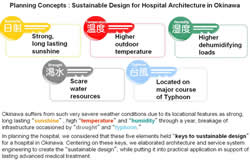Last Uploaded: April, 2011
Okinawa Prefectural Nanbu Medical Center & Children's Medical Center
Special Features
| Q-1 Indoor Environment |
- Building envelope suitable for Okinawa's climatic conditions (multi-functional vertical louvers, roof insulation and rooftop garden)
- Improved room environment and energy efficiency with the use of task/ambient A/C system in 4-bed inpatient rooms (cool air is radiated from ceiling)
- Improved low-humidity environment and energy efficiency through humidity control of major systems and ward systems using desiccant A/C
|
| Q-2 Quality of Service |
- Individual interior planning for adult and children areas
- Okinawa's first medical facility with seismic-isolated structure, ensuring reliability as disaster response hub
- Improved maintenance and upgrade performance and disaster recovery of A/C systems by adding ISS in the 1st and 3rd floor ceilings where the main A/C rooms are located
- Enhanced energy-supply reliability through dual system for power and cold-water supply systems and multi-energy heat source system
|
| Q-3 Outdoor Environment on Site |
- Community-based medical facility equipped with meeting space for adult/children and rooftop garden
- Amahaji, structure typically seen in Okinawa's traditional houses, surround the building and shelter pedestrians from rain and the intense sun
|
| LR-1 Energy |
- Reduced thermal load by installing vertical louvers throughout the building
- 41% reduction in energy consumption by utilizing desiccant A/C system with water-conveyance cold-source system using mid-large temperature difference suitable for Okinawa's high-humidity environment.
|
| LR-2 Resources and Materials |
- Use of large amount of A/C condensation water created due to high-humidity conditions, in addition to rainwater, accounting for 48% of general service water usage, as a water-saving measure for water-poor Okinawa
|
| LR-3 Off-site Environment |
- Sterilization of waste water prior to discharge in order to eliminate threat of infection from advanced medical care
- Ample distance from adjacent sites and vertical louvers providing relief from daytime sun exposure and nighttime light pollution
|
Other Features
| Front entrance furnished with large eaves (approximately 1,000m2) to be used as triage space for potential major aircraft and tour bus accidents due to the hospital's close proximity to Naha airport and interchange |
These cases are described based on assessment results obtained using
CASBEE.
CASBEE is a method for rating the environmental performance of buildings using
Building Environmental Efficiency (BEE) as an indicator, which is based on the results of
separate scores obtained for Q-1~Q-3 (Quality) and LR-1~LR-3 (Load Reduction).













 Next Building
Next Building















 | Copyright © 2008 Institute for Building Environment and Energy Conservation, All Rights Reserved.
| Copyright © 2008 Institute for Building Environment and Energy Conservation, All Rights Reserved.